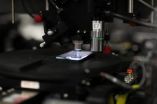(Press-News.org) WASHINGTON, June 18, 2014—Your smartphone's display glass could soon be more than just a pretty face, thanks to new technology developed by researchers from Montreal and the New York-based company Corning Incorporated. The team has created the first laser-written light-guiding systems that are efficient enough to be developed for commercial use. They describe their work in a paper published today in The Optical Society's (OSA) open-access journal, Optics Express.
This revolutionary work could open up new real estate in the phone by embedding the glass with layer upon layer of sensors, including ones that could take your temperature, assess your blood sugar levels if you're diabetic or even analyze DNA.
The researchers have used their new technology to build two completely transparent systems—a temperature sensor and a new system for authenticating a smartphone using infrared light—into a type of glass that's currently used in most smartphones.
In addition to biomedical sensors, the technology could also eventually allow computing devices to be embedded into any glass surface, such as windows or tabletops, creating the transparent touchscreens seen in movies like Avatar and Iron Man, the researchers say.
"We're opening the Pandora's box at the moment," says paper co-author Raman Kashyap, a professor of electrical engineering and engineering physics at Polytechnique Montreal in Canada. Now that the technique is viable, "it's up to people to invent new uses" for it, he says.
To make their see-through temperature-sensing and phone-authentication systems, the researchers turned to photonics. While electronic devices transmit information via electrons, photonic devices use light. The researchers used lasers to carve out transparent pathways called waveguides into the glass. These waveguides act as tunnels that channel light, analogous to the way electronic wires convey electrical signals, and form the basis for a host of applications.
Although people have used lasers to make photonic waveguides before, this is the first time anyone has applied the technique to Gorilla® Glass, a tough glass with high internal stress and low irregularity, developed by Corning that's now used in billions of electronic devices.
According to first author Jerome Lapointe of Polytechnique Montreal, this new photonic waveguide is the best that's ever been made using lasers. While no waveguide is perfect—light will inevitably leak out due to imperfections—the new waveguides created by the team are 10 times better at minimizing such loss than previous ones made with lasers, he says. And because Gorilla Glass has greater internal stress and less irregularities than other types of glass, the waveguides are smoother and better at preventing light from escaping. This also means the researchers can use lower energy ultra-short laser pulses at a high repetition rate, which results in smoother and more efficient waveguides.
Current techniques such as photolithography—which uses light-sensitive chemicals to etch or deposit material—are very good at minimizing light loss, but the team's laser method is cheaper and simpler, Lapointe says. Also, photolithography restricts waveguides to the surface of the glass. But using lasers enables researchers to make waveguides at any depth, allowing them to create many applications, one on top of each other, like layers in a cake. Layering the waveguides within the glass itself paves the way for more compact devices, which means you could squeeze more apps into your phone.
Temperature Sensors and Secure Transactions
To demonstrate their technique, the researchers built a standard type of temperature sensor that consists of a straight and a curved waveguide. When the glass heats up, it expands and changes the path length of the waveguides. By measuring how the light that emerges from one waveguide interferes with light from the other, the device can measure temperature – yours or that of anything it touches.
The researchers also developed a new method for authenticating a smartphone based on waveguides with holes at various locations. The light that escapes through those holes creates a pattern that is unique to their arrangement. The idea is that each phone would have its own unique pattern, like a fingerprint, which could then be read by an infrared detector to confirm the identity of the phone as an additional layer of security for making financial transactions using smartphones. Such transactions could be relatively safe because instead of using radio frequency they use infrared light, which is blocked by most materials and therefore cannot be copied through a pocket or purse.
Both the temperature sensor and authentication system are being patented and the team is hoping to optimize them for use in consumer devices.
"We are actively looking to partner with industry to exploit this technology," Kashyap says. With focused development, he adds, the two systems could potentially be integrated commercially into smartphones within a year.
INFORMATION:
The other members of the team are Mathieu Gagné of Polytechnique Montreal and Ming-Jun Li of Corning.
Paper: "Making Smart Phones Smarter with Photonics," J. Lapointe et al., Optics Express, vol. 22, Issue 13, pp. 15473-15483 (2014). (http://www.opticsinfobase.org/oe/abstract.cfm?uri=oe-22-13-15473)
EDITOR'S NOTE: Images are available to members of the media upon request. Contact Lyndsay Meyer, lmeyer@osa.org.
About Optics Express
Optics Express reports on new developments in all fields of optical science and technology every two weeks. The journal provides rapid publication of original, peer-reviewed papers. It is published by The Optical Society and edited by Andrew M. Weiner of Purdue University. Optics Express is an open-access journal and is available at no cost to readers online at http://www.OpticsInfoBase.org/OE.
About OSA
Founded in 1916, The Optical Society (OSA) is the leading professional society for scientists, engineers, students and business leaders who fuel discoveries, shape real-world applications and accelerate achievements in the science of light. Through world-renowned publications, meetings and membership programs, OSA provides quality research, inspired interactions and dedicated resources for its extensive global network of professionals in optics and photonics. For more information, visit http://www.osa.org.
Making smartphones smarter with see-through sensors
New technology for carving light into Gorilla® Glass could let manufacturers pack more apps into new real estate: The display glass itself
2014-06-18
ELSE PRESS RELEASES FROM THIS DATE:
Combatting cuckoos
2014-06-18
How do animals use their distinctive patterning to recognize each other? For some birds, recognizing one's own eggs can be a matter of life or death. In a new study, researchers from Harvard University and the University of Cambridge show that many birds parasitized by the Common Cuckoo have evolved distinctive pattern signatures on their eggs in order to distinguish them from those laid by a cuckoo cheat. The study reveals that these signatures provide a powerful defense against cuckoo trickery, helping host birds to reject cuckoo eggs before they hatch and destroy the ...
Columbia Engineering team finds thousands of secret keys in Android apps
2014-06-18
New York, NY—June 18, 2014—In a paper presented—and awarded the prestigious Ken Sevcik Outstanding Student Paper Award—at the ACM SIGMETRICS conference on June 18, Jason Nieh, professor of computer science at Columbia Engineering, and PhD candidate Nicolas Viennot reported that they have discovered a crucial security problem in Google Play, the official Android app store where millions of users of Android, the most popular mobile platform, get their apps.
"Google Play has more than one million apps and over 50 billion app downloads, but no one reviews what gets put into ...
New manufacturing methods needed for 'soft' machines, robots
2014-06-18
WEST LAFAYETTE, Ind. — Researchers have developed a technique that might be used to produce "soft machines" made of elastic materials and liquid metals for potential applications in robotics, medical devices and consumer electronics.
Such an elastic technology could make possible robots that have sensory skin and stretchable garments that people might wear to interact with computers or for therapeutic purposes.
However, new manufacturing techniques must be developed before soft machines become commercially practical, said Rebecca Kramer, an assistant professor of mechanical ...
Quest for education creating graying ghost towns at top of the world
2014-06-18
Ethnic Tibetan communities in Nepal's highlands are rapidly shrinking as more parents send their children away for a better education and modern careers, a trend that threatens to create a region of graying ghost towns at the top of the world, according to a study that includes Dartmouth College.
The findings, which have major social and demographic implications for the Himalayan region, appear in the journal Mountain Research and Development. A PDF of the study is available on request.
Taken together, the outmigration of young people, a low birth rate and population ...
Counterterrorism, ethics, and global health
2014-06-18
The surge in murders of polio vaccination workers in Pakistan has made headlines this year, but little attention has been devoted to the ethical issues surrounding the global health impact of current counterterrorism policy and practice. An essay in the Hastings Center Report reviews the range of harms to population health traceable to counterterrorism operations.
It also identifies concerns involving moral agency and responsibility – specifically of humanitarian health workers, military medical personnel, and national security officials and operatives – and it highlights ...
Proposed children's study needs refinement, report finds
2014-06-18
PRINCETON, N.J.—A study that would track the health of 100,000 babies to age 21 has been put on hold following the release of an assessment report issued June 16 by the National Research Council and Institute of Medicine (IOM).
While the congressionally mandated report endorses several aspects of the proposed study design of the National Children's Study (NCS), the authors – including Sara McLanahan, the William S. Tod Professor of Sociology and Public Affairs at Princeton University's Woodrow Wilson School of International and Public Affairs – are critical of the sampling ...
False negative results found in prognostic testing for breast cancer
2014-06-18
A recent study evaluating HER2 testing in a large cohort of women with breast cancer found important limitations in the conventional way HER2 testing is performed in the US and internationally.
Dartmouth-Hitchcock Norris Cotton Cancer Center physicians and researchers retested tumor samples from a large group of women and found that 22 out of 530 women had their tumor type incorrectly classified. They reported their findings in a publication titled "Assessing the Discordance Rate between Local and Central HER2 Testing in Women with Locally Determined HER2-Negative Breast ...
New Stanford blood test identifies heart-transplant rejection earlier than biopsy can
2014-06-18
Stanford University researchers have devised a noninvasive way to detect heart-transplant rejection weeks or months earlier than previously possible. The test, which relies on the detection of increasing amounts of the donor's DNA in the blood of the recipient, does not require the removal of any heart tissue.
"This test appears to be safer, cheaper and more accurate than a heart biopsy, which is the current gold standard to detect and monitor heart-transplant rejection," said Stephen Quake, PhD, professor of bioengineering and of applied physics. "We believe it's likely ...
How a new approach to funding Alzheimer's research could pay off
2014-06-18
More than 5 million Americans suffer from Alzheimer's disease, the affliction that erodes memory and other mental capacities, but no drugs targeting the disease have been approved by the U.S. Food and Drug Administration since 2003. Now a paper by an MIT professor suggests that a revamped way of financing Alzheimer's research could spur the development of useful new drugs for the illness.
"We are spending tremendous amounts of resources dealing with this disease, but we don't have any effective therapies for it," says Andrew Lo, the Charles E. and Susan T. Harris Professor ...
Maybe birds can have it all: Dazzling colors and pretty songs
2014-06-18
ITHACA, N.Y. – A study of one of the world's largest and most colorful bird families has dispelled a long-held notion, first proposed by Charles Darwin, that animals are limited in their options to evolve showiness. The study – the largest of its kind – was published today in the Proceedings of the Royal Society B.
The natural world is full of showstoppers – birds with brilliant colors, exaggerated crests and tails, intricate dance routines, or virtuosic singing. But it's long been thought that these abilities are the result of trade-offs. For a species to excel in one ...
LAST 30 PRESS RELEASES:
Survey reveals ethical gaps slowing AI adoption in pediatric surgery
Stimulant ADHD medications work differently than thought
AI overestimates how smart people are, according to HSE economists
HSE researchers create genome-wide map of quadruplexes
Scientists boost cell "powerhouses" to burn more calories
Automatic label checking: The missing step in making reliable medical AI
Low daily alcohol intake linked to 50% heightened mouth cancer risk in India
American Meteorological Society announces Rick Spinrad as 2026 President-Elect
Biomass-based carbon capture spotlighted in newly released global climate webinar recording
Illuminating invisible nano pollutants: advanced bioimaging tracks the full journey of emerging nanoscale contaminants in living systems
How does age affect recovery from spinal cord injury?
Novel AI tool offers prognosis for patients with head and neck cancer
Fathers’ microplastic exposure tied to their children’s metabolic problems
Research validates laboratory model for studying high-grade serous ovarian cancer
SIR 2026 delivers transformative breakthroughs in minimally invasive medicine to improve patient care
Stem Cell Reports most downloaded papers of 2025 highlight the breadth and impact of stem cell research
Oxford-led study estimates NHS spends around 3% of its primary and secondary care budget on the health impacts of heat and cold in England
A researcher’s long quest leads to a smart composite breakthrough
Urban wild bees act as “microbial sensors” of city health.
New study finds where you live affects recovery after a hip fracture
Forecasting the impact of fully automated vehicle adoption on US road traffic injuries
Alcohol-related hospitalizations from 2016 to 2022
Semaglutide and hospitalizations in patients with obesity and established cardiovascular disease
Researchers ‘listen in’ to embryo-mother interactions during implantation using a culture system replicating the womb lining
How changing your diet could help save the world
How to make AI truly scalable and reliable for real-time traffic assignment?
Beyond fragmented markets: A new framework for efficient and stable ride-pooling
Can shape priors make road perception more reliable for autonomous driving?
AI tracks nearly 100 years of aging research, revealing key trends and gaps
Innovative techniques enable Italy’s first imaging of individual trapped atoms
[Press-News.org] Making smartphones smarter with see-through sensorsNew technology for carving light into Gorilla® Glass could let manufacturers pack more apps into new real estate: The display glass itself




